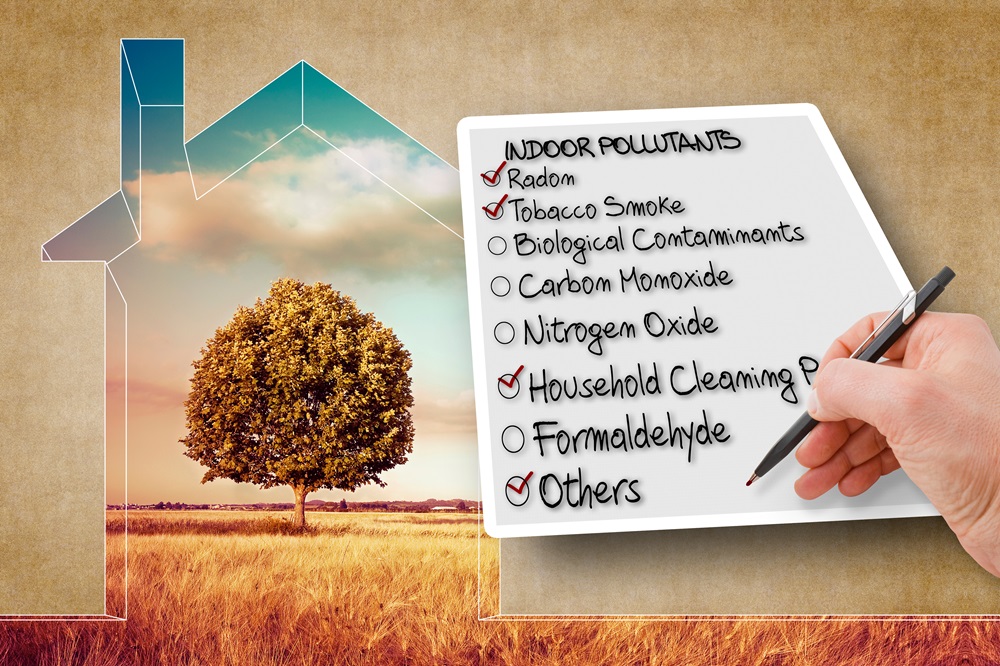Indoor air quality (IAQ) has become a significant concern in recent years, especially in densely populated metropolitan areas like New York and New Jersey. With a variety of factors contributing to the quality of air we breathe indoors, it’s crucial to understand these elements and how they can be mitigated to ensure healthier living and working environments.
The Impact of Biomass Burning on Air Quality
A recent study titled “Assessment of the Contribution of Local and Regional Biomass Burning on PM2.5 in New York/New Jersey Metropolitan Area” provides valuable insights into the sources of fine particulate matter in the NY/NJ metropolitan area. The research, conducted by Subraham Singh, Glen Johnson, David W. DuBois, and Ilias G. Kavouras, highlights that biomass burning, secondary inorganic (i.e., ammonium sulfate and nitrate), and primary traffic exhausts were the predominant sources of particulate matter.
Biomass burning refers to the burning of living and dead vegetation, including wood, leaves, and crop residues. It can be caused by natural events such as wildfires, or by human activities such as the intentional burning of vegetation for agricultural purposes. In urban environments like New York and New Jersey, biomass burning can also come from domestic heating during the cold months.
The study found that the contributions of secondary nitrate, primary traffic exhausts, and diesel particles did not change (or slightly increased) over time. This finding is significant as it points to the persistent problem of air pollution from these sources. The researchers also noted that the declining trends of PM mass in all four sites they studied were very well correlated with decreasing secondary sulfate levels due to SO emission reductions by coal-fired power plants.
This research underscores the importance of controlling and managing sources of biomass burning, as well as traffic and industrial emissions, to improve air quality in urban environments.
Indoor Air Quality in Workplaces: A Case Study of Nail Salons
While the impact of outdoor air pollution on IAQ is significant, it’s also crucial to consider the quality of air in indoor environments where people spend most of their time. A study titled “Assessing Indoor Air Quality in New York City Nail Salons” provides a glimpse into the IAQ issues in workplaces, specifically nail salons, in New York City.
The study found that nail salon workers commonly experience skin problems, respiratory irritation, and headaches, which are consistent with indoor air quality problems. These health issues can be attributed to the various chemicals found in nail salon products, including carcinogens (formaldehyde), endocrine disruptors (phthalates), teratogens (toluene), sensitizers (methacrylates), and respiratory irritants (acetone, acetonitrile, and isopropyl acetate).
The Role of Ventilation in Indoor Air Quality
The study on nail salons also highlighted the role of ventilation in maintaining good indoor air quality. In 2015, New York State promulgated regulations to improve IAQ in salons. These regulations required nail salons to install mechanical general ventilation and local exhaust ventilation systems to provide outside air and to exhaust contaminated air from the general salon environment and from manicure and pedicure stations directly to the outside.
The implementation of these regulations underscores the importance of proper ventilation in maintaining good indoor air quality. By ensuring a steady flow of fresh air, the concentration of pollutants in the indoor environment can be significantly reduced, thereby reducing the risk of health issues associated with poor IAQ.
Indoor Air Quality and Health
The health effects associated with poor indoor air quality are well-documented. According to the nail salon study, workers commonly experience skin problems, respiratory irritation, and headaches. More severe health issues can also arise. For instance, the inhalation of atmospheric aerosol is linked to the onset of cardiovascular and cerebrovascular diseases, including myocardial infarctions, ischemic stroke, and cardiac arrhythmia.
These health issues highlight the importance of maintaining good indoor air quality. By understanding and controlling the sources of indoor air pollution, we can create healthier living and working environments and reduce the risk of health problems associated with poor IAQ.
The Impact of COVID-19 Lockdowns on Indoor Air Quality
The COVID-19 pandemic and the resulting lockdowns have had a profound impact on our lives, including the quality of air in our homes. A study titled “Effects of covid-induced lockdown on inhabitants’ perception of indoor air quality in naturally ventilated homes” by Jesica Fernández-Agüera, Samuel Domínguez-Amarillo, M. Campano, and Hanan Al-Khatri, provides an interesting perspective on this issue.
The researchers found that during the lockdown, when people were spending more time indoors, there was a heightened awareness of indoor air quality. According to the study, “During lockdown, however, users came to attach greater importance to air quality, and a greater sensitivity to odours and a heightened awareness of CO2 concentration prompted them to ventilate their homes more frequently.”
This finding underscores the importance of awareness in maintaining good indoor air quality. When people are aware of the quality of air in their homes, they are more likely to take steps to improve it, such as increasing ventilation.
Indoor Air Quality in Residential Buildings
Another study titled “Investigation of Indoor Air Quality in Residential Buildings by Measuring CO2 Concentration and a Questionnaire Survey” by Shunichi Hattori, T. Iwamatsu, Teruhisa Miura, F. Tsutsumi, and Nobuyuki Tanaka, provides valuable insights into the state of indoor air quality in residential buildings.
The researchers measured CO2 concentrations in 24 occupied houses and found that the use of combustion heaters increased the concentration of CO2, leading to indoor air pollution. The study also found that as outdoor temperature decreased, the frequency of ventilation decreased simultaneously, and CO2 concentration increased.
Interestingly, the researchers found a discrepancy between the actual indoor air quality and the occupants’ perception of it. The study states, “Results of the questionnaire survey revealed that the actual IAQ in each house did not match the level of awareness its occupants had regarding ventilation.”
This finding highlights the need for better education and awareness about indoor air quality. Even though people may think that the air in their homes is clean, this may not always be the case. Regular monitoring of indoor air quality and taking steps to improve it, such as increasing ventilation and using air purifiers, can help ensure a healthier living environment.
The Role of Combustion Heaters in Indoor Air Quality
The use of combustion heaters, as highlighted in the study by Hattori and colleagues, can significantly impact indoor air quality. Combustion heaters, such as wood-burning stoves and gas heaters, can emit pollutants like carbon monoxide, nitrogen dioxide, and particulate matter into the indoor environment. These pollutants can cause a range of health issues, from minor irritations like headaches and dizziness to more serious conditions like respiratory diseases and heart problems.
The study’s findings emphasize the importance of using combustion heaters responsibly and ensuring adequate ventilation when they are in use. As the researchers note, “the use of combustion heaters increased the concentration of CO2 and led to indoor air pollution.” This is a crucial point to consider, especially during the colder months when the use of these heaters is more prevalent.
The Importance of Ventilation in Maintaining Indoor Air Quality
Both studies underscore the importance of ventilation in maintaining good indoor air quality. Ventilation helps to remove or dilute indoor airborne pollutants coming from indoor sources. This reduces the level of contaminants and improves indoor air quality.
In the study on the effects of the COVID-19 lockdown, the researchers found that a heightened awareness of CO2 concentration prompted inhabitants to ventilate their homes more frequently. Similarly, the study on residential buildings found that as outdoor temperature decreased, the frequency of ventilation decreased, leading to an increase in CO2 concentration.
These findings highlight the need for effective ventilation strategies in homes and other indoor environments. This could include natural ventilation, such as opening windows and doors, and mechanical ventilation, such as using exhaust fans and air handling units.
Conclusion
Indoor air quality (IAQ) is a critical aspect of our health and well-being, particularly in densely populated metropolitan areas like New York and New Jersey. The quality of the air we breathe indoors is influenced by a myriad of factors, both external and internal, and understanding these elements is key to creating healthier living and working environments.
Research has shown that outdoor pollution sources, such as biomass burning and traffic emissions, significantly impact indoor air quality. Studies like “Assessment of the Contribution of Local and Regional Biomass Burning on PM2.5 in New York/New Jersey Metropolitan Area” highlight the need for controlling and managing these sources to improve air quality in urban environments.
However, the quality of air indoors is not solely determined by outdoor pollution. Indoor activities and conditions play a significant role too. The use of combustion heaters, for instance, can lead to increased CO2 concentrations and indoor air pollution, as revealed in the study “Investigation of Indoor Air Quality in Residential Buildings by Measuring CO2 Concentration and a Questionnaire Survey.”
Workplaces, such as nail salons, can also face unique IAQ challenges due to the use of various chemicals. These issues underscore the importance of proper ventilation and the use of safer products to ensure a healthier indoor environment.
The COVID-19 pandemic has further underscored the importance of indoor air quality. The lockdowns led to a heightened awareness of IAQ, prompting people to ventilate their homes more frequently, as shown in the study “Effects of covid-induced lockdown on inhabitants’ perception of indoor air quality in naturally ventilated homes.”
In conclusion, improving indoor air quality is a multifaceted challenge that requires a comprehensive understanding of the various sources of indoor air pollution and effective strategies to mitigate them. From controlling sources of outdoor air pollution to improving ventilation systems in indoor environments, there are several strategies that can be employed to improve IAQ. With concerted efforts from policymakers, businesses, and individuals, it’s possible to improve the quality of air we breathe indoors, leading to healthier and more comfortable living and working environments.




